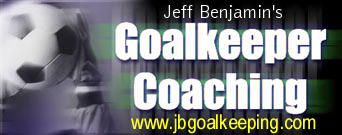
|
"Outstanding keeper instruction. This is a must for goalkeepers and coaches." —Ottawa Internationals S.C. web site, Ottawa, Canada |

|

|
Top |
Goalkeeping Tips, Tidbits and Random Thoughts
An athlete talking to themsleves during competition is hardly a new phenomenon.... The talk does not have to be vocal. By merely thinking you are talking to yourself and sending a message.
-- Tony DiCicco, Goalkeeper Soccer Training Manual
If you have a question, comment or rebuttal you'd like to see addressed here, send me email. I will post your mail to the blog at my discretion unless you specify otherwise.
Action bias among elite soccer goalkeepers
Action bias among elite soccer goalkeepers: The case of penalty kicks. Huh? What in the world does that mean?A forthcoming study shows that most goalkeepers will pick a side (based on reading the shooter, gut feel, or just plain guessing) and dive there, when in fact the optimal strategy is to stay in the middle and react—as I often advocate, especially for younger players.
So why then do goalkeepers pick a direction and dive? That's the title of the article. There is a bias towards "action": i.e., doing something. The thought is that if you're going to get scored on anyway, you might as well get scored on while trying hard than just standing there doing nothing. Certainly, a keeper who never moves while the ball goes into the corner of the net doesn't usually provoke a positive reaction from teammates or coach.
However, almost 30% of the 286 penalties included in the study were struck to the middle third of the net, and the goalkeeper's chance of saving such a shot is about 60%, versus about a 25-30% chance of saving a shot hit to one side even when the keeper dives the correct way. So why dive to the side at all? Because "an identical negative outcome (a goal being scored) is perceived to be worse when it follows inaction rather than action." In other words, keepers are biased towards action.
The upshot of all this? I think it supports my theory of stopping penalty kicks: don't guess and dive, read the shooter and get a feel for where you think the shot will go, get prepared to go that way, but don't go too soon and leave yourself some ability to react after the ball is struck. That strategy works quite successfully for me, and I've saved more than my fair share of penalties struck down the middle.
Labels: Penalty Kicks
Save the easy PKs
The high school girls team I coach opened their season tonight. With us up 1-0 and 13 minutes left, the other team is awarded a penalty kick (and rightly so). My goalkeeper, who has played the position for several years but has never had any formal training, steps to her line. We haven't really worked on PKs, but I have passed along my advice to not guess and simply react to the shot if you don't get a strong read. The shot goes right down the middle, and she makes the save without even moving. I don't know if it was poorly hit, or if the kicker expected the goalkeeper to guess and dive out of the way.Regardless, what could have been a 1-1 game and a huge momentum swing ended up in a 2-0 victory for us.
Save all the ones you should, then save a few of the ones you shouldn't.
Labels: Penalty Kicks
Optimal penalty kicks
The latest issue of the NSCAA Soccer Journal has a reprint of an article from the 1988 archives: "Psychological Stress in Penalty Kicks". The focus of the article is more on the kick taker, but an interesting stat emerges: in the 1986 World Cup, only 30% of the kicks were taken "optimally". That is, only 30% of the kicks were placed in the zone one meter from either post. Fifty percent were one to three meters from the center of the goal, and a full 20% (one of five!) were put down the center two meters of the goal.The reason for such poorly placed kicks is often psychological stress, as noted by the title of the article. But the implication for the goalkeeper is clear: a large portion of penalty kicks might be saved simply by reacting to the ball, since they are within range of an easy dive. Reading the shooter is still beneficial, since a well-struck shot, even if not perfectly placed, can still be tough to save. Any edge in reaction a goalkeeper can glean can be critical. But perhaps you can go too soon and put yourself out of position for what would have been an easy save.
Personally, I think there is a lot of merit in this approach. I do quite well with penalties, stopping over 50% the last few years. I get a read on the shooter, but only to get a "lean" in that direction--I don't fully commit. That way I still have a chance to react to poorly hit shots, and I have saved a number of PKs in just that way. The shot ended up coming right down the middle.
Just think... if you could save 70% of your penalties this way, you'd be a hero!
Labels: Penalty Kicks
9th hardest thing to do in sports
USA Today ranks saving a penalty kick as number 9 in their list of the 10 Hardest Things to do in Sports.Labels: Penalty Kicks
Hoops and penalties
And if you didn't think that playing basketball or other ball/hand sports helps develop a better goalkeeper, then why would Manchester United call new signing Tim Howard "one of the best basketball players to be playing in the MLS."?Oh, and getting back to penalty kicks -- I am currently 3-for-3 stopping penalties in my adult summer league this season. Two to my left, one to my right. Just luck? Hardly. You can learn to "read" penalty takers. (Although I do need to talk to my defenders about all those fouls....)
Reading the shooter
I have had discussions with people who don't believe you can learn to "read the shooter" on penalty kicks. They're wrong -- you can learn to improve your chances of making a stop; it's not random. For a case in point, see peterb's post to this thread on the SoccerCoaching.net discussion forum.Labels: Penalty Kicks